Related Research Articles

The Ichneumonidae, also known as ichneumon wasps, ichneumonid wasps, ichneumonids, or Darwin wasps, are a family of parasitoid wasps of the insect order Hymenoptera. They are one of the most diverse groups within the Hymenoptera with roughly 25,000 species described as of 2016. However, this likely represents less than a quarter of their true richness as reliable estimates are lacking, along with much of the most basic knowledge about their ecology, distribution, and evolution. It is estimated that there are more species in this family than there are species of birds and mammals combined. Ichneumonid wasps, with very few exceptions, attack the immature stages of holometabolous insects and spiders, eventually killing their hosts. They thus fulfill an important role as regulators of insect populations, both in natural and semi-natural systems, making them promising agents for biological control.
Thomas Ansell Marshall was an English cleric and entomologist, mainly interested in Hymenoptera. He was the son of Thomas Marshall, one of the original members of the Royal Entomological Society of London.
Claude Morley was an English antiquary and entomologist who specialised in Hymenoptera and Diptera. He has been described by Peter Marren as "Suffolk's best-known entomologist".
Thomas Desvignes was an English entomologist who specialised in Hymenoptera. He wrote (1856) Catalogue of British Ichneumonidae in the collection of the British Museum (London) and many scientific papers describing new species. Desvignes was a member of the Entomological Society of London from 1849. His collection of Ichneumonidae is in the Natural History Museum, London.
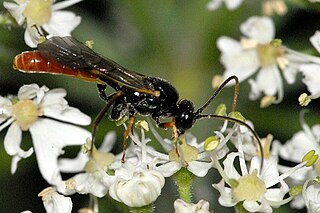
The Tryphoninae comprise a worldwide subfamily of the parasitic wasp family Ichneumonidae.

Ichneumoninae is a worldwide subfamily of the parasitic wasp family Ichneumonidae.
Joseph Kriechbaumer, Munich was a German entomologist who specialised in Hymenoptera especially Ichneumonidae.
In this checklist are presented all wasp species of family Ichneumonidae.
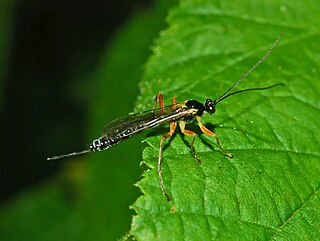
Polysphincta boops is a species belonging to the family Ichneumonidae subfamily Pimplinae.

Pimpla are a worldwide genus of the parasitic wasp family Ichneumonidae.
Mesoleiini is a tribe of parasitic wasps in the subfamily Ctenopelmatinae.
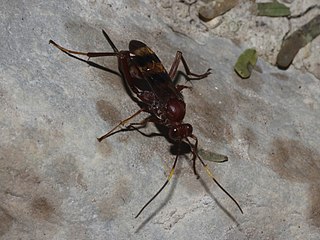
Lanugo is a genus of wasps belonging to the family Ichneumonidae. The name refers to the Latin word lanugo, meaning soft, downy hair, due to the hair found on species within this genus. This genus differs from the otherwise similar genus Compsocryptus by its "moderately short, straight ovipositor rather than a longer upcurved one, axillus vein closer to anal margin of hind wing, front size of areolet narrower."

Eridolius is a genus of wasps.

Polysphincta is a genus belonging to the family Ichneumonidae subfamily Pimplinae.

Euceros is a cosmopolitan genus of ichneumon wasps in the family Ichneumonidae.
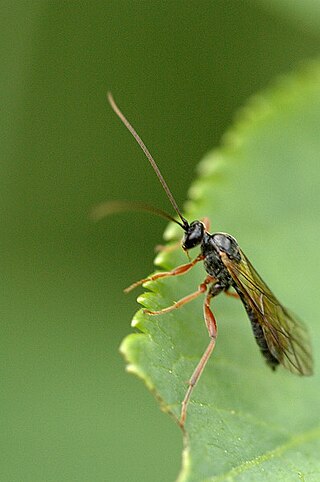
Mesoleius is a genus of ichneumon wasps in the family Ichneumonidae. There are at least 160 described species in Mesoleius.
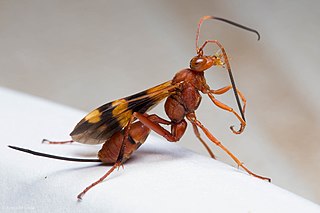
Compsocryptus is a genus of ichneumon wasps in the family Ichneumonidae.
Itoplectis is a genus of insect belonging to the family Ichneumonidae.
Benjaminia is a genus of parasitoid wasps belonging to the family Ichneumonidae.
Eclytus is a genus of parasitoid wasps belonging to the family Ichneumonidae.
References
- ↑ Parfitt, E. (1882) Two new species of Ichneumonidae., Entomologist's Monthly Magazine. 18:272-273
- ↑ Thomson, C.G. (1894) XLX. Bidrag till kannedom om slagtet Mesoleius., Opuscula Entomologica. Lund. XIX:2025-2079
- ↑ Some genera of British and European Mesoleiini (Hym., Ichneumonidae: Ctenopelmatinae) in the National Museums of Scotland, including a new species of … MR Shaw, DR Kasparyan - ENTOMOLOGISTS MONTHLY MAGAZINE, 2003